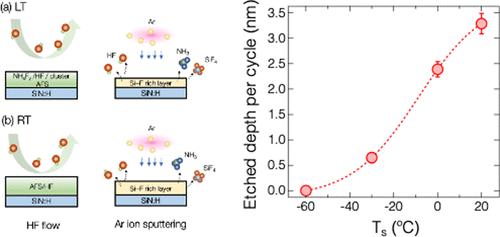当前位置:
X-MOL 学术
›
Chem. Mater.
›
论文详情
Our official English website, www.x-mol.net, welcomes your
feedback! (Note: you will need to create a separate account there.)
In Situ Monitoring Surface Reactions in Cryogenic Atomic Layer Etching of Silicon Nitride by Alternating Surface Modification with Hydrogen Fluoride Dose and Ar Plasmas
Chemistry of Materials ( IF 7.2 ) Pub Date : 2024-11-07 , DOI: 10.1021/acs.chemmater.4c01835 Shih-Nan Hsiao, Makoto Sekine, Yuki Iijima, Masaru Hori
Chemistry of Materials ( IF 7.2 ) Pub Date : 2024-11-07 , DOI: 10.1021/acs.chemmater.4c01835 Shih-Nan Hsiao, Makoto Sekine, Yuki Iijima, Masaru Hori

|
Cryogenic atomic layer etching (ALE) represents a promising technique for achieving subnanoscale material removal in semiconductor processes, owing to its unique self-limiting surface-adsorbing reactions. This paper presents a cryogenic ALE method for SiN, utilizing surface modification with a hydrogen fluoride (HF) dose and an Ar etch step for removing the modification layer. The surface reactions and etching mechanism were examined using in situ monitoring techniques, including spectroscopic ellipsometry and attenuated total reflectance Fourier transform infrared spectroscopy (ATR-FTIR). Our observations reveal a self-limiting etching behavior for SiN and a reduction in the etch amount per cycle (EPC) with a decreasing substrate temperature. During the HF dose step, in situ ATR-FTIR spectra indicate the formation of a surface-adsorbed layer containing ammonium fluorosilicate (AFS) on the SiN surface. Subsequently, during the Ar plasma etching step, both the AFS layer and the surface-adsorbed species were removed. At lower substrate temperatures, the stability of the AFS layer and surface-absorbed species increased, resulting in a reduction in EPC. Through the control of Ar ion energy and substrate temperature, the manipulation of EPC ranging from several nanometers to a few angstroms in atomic layer etching is achieved, offering potential utility in nanoscale device applications utilizing silicon nitride.
中文翻译:

通过氟化氢剂量和 Ar 等离子体交替表面改性对氮化硅低温原子层刻蚀进行原位监测表面反应
低温原子层刻蚀 (ALE) 由于其独特的自限性表面吸附反应,代表了在半导体工艺中实现亚纳米级材料去除的一种很有前途的技术。本文提出了一种 SiN 的低温 ALE 方法,该方法利用氟化氢 (HF) 剂量的表面改性和 Ar 蚀刻步骤去除改性层。使用原位监测技术检查表面反应和刻蚀机理,包括光谱椭圆偏振法和衰减全反射傅里叶变换红外光谱 (ATR-FTIR)。我们的观察揭示了 SiN 的自限性蚀刻行为,并且随着衬底温度的降低,每周期蚀刻量 (EPC) 减少。在 HF 剂量步骤中,原位 ATR-FTIR 光谱表明在 SiN 表面上形成了含有氟硅酸铵 (AFS) 的表面吸附层。随后,在 Ar 等离子体刻蚀步骤中,AFS 层和表面吸附的物质都被去除。在较低的衬底温度下,AFS 层和表面吸收物质的稳定性增加,导致 EPC 减少。通过控制 Ar 离子能量和衬底温度,实现了原子层蚀刻中从几纳米到几埃的 EPC 操作,为利用氮化硅的纳米级器件应用提供了潜在的实用性。
更新日期:2024-11-09
中文翻译:

通过氟化氢剂量和 Ar 等离子体交替表面改性对氮化硅低温原子层刻蚀进行原位监测表面反应
低温原子层刻蚀 (ALE) 由于其独特的自限性表面吸附反应,代表了在半导体工艺中实现亚纳米级材料去除的一种很有前途的技术。本文提出了一种 SiN 的低温 ALE 方法,该方法利用氟化氢 (HF) 剂量的表面改性和 Ar 蚀刻步骤去除改性层。使用原位监测技术检查表面反应和刻蚀机理,包括光谱椭圆偏振法和衰减全反射傅里叶变换红外光谱 (ATR-FTIR)。我们的观察揭示了 SiN 的自限性蚀刻行为,并且随着衬底温度的降低,每周期蚀刻量 (EPC) 减少。在 HF 剂量步骤中,原位 ATR-FTIR 光谱表明在 SiN 表面上形成了含有氟硅酸铵 (AFS) 的表面吸附层。随后,在 Ar 等离子体刻蚀步骤中,AFS 层和表面吸附的物质都被去除。在较低的衬底温度下,AFS 层和表面吸收物质的稳定性增加,导致 EPC 减少。通过控制 Ar 离子能量和衬底温度,实现了原子层蚀刻中从几纳米到几埃的 EPC 操作,为利用氮化硅的纳米级器件应用提供了潜在的实用性。


















































 京公网安备 11010802027423号
京公网安备 11010802027423号